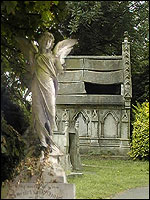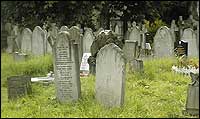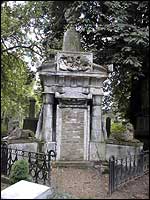Kensal Green Cemetery, Kensal Green, London
Created | Updated Jan 21, 2012

London is famous for its green open spaces, Royal Parks and mews, but there exist vast expanses of greenery that usually go unvisited by most tourists - cemeteries.
One of the most beautiful and ramshackle of London's cemeteries can be found in Kensal Green, a rundown suburb in north west London in between Harlesden, Paddington and Kensal Rise. You access the cemetery via the Harrow Road which is lined with kebab houses, second-hand furniture shops and scrap yards. The road is also one of the main arteries for London's traffic but there is only one entrance for cars which is located next to a used car show room. However, there are several entrances for pedestrians.
You can get there by taking the number 18 bus which will drop you right outside the cemetery's west gate. Alternatively, you could take the London Underground to Kensal Green station on the Bakerloo line; take a left out the station and another left and the cemetery is in front of you on the other side of the road. One final way to get there is to take the Silverlink train to Kensal Rise. As you come out of the station, take a right down Chamberlayne Road and walk for about ten minutes. You'll come to a major crossroads; this is the Harrow Road. Take a right and the cemetery is two minutes on your left. The bus and Silverlink routes are in zone two for travelcard users. Kensal Green station on the Bakerloo line has its own special fare system, so Zone one and two travel cards are invalid.

Kensal Green cemetery is London's oldest public burial ground and has an eclectic mix of architectural styles. The layout of the graves appears to have no discernible order or pattern. You will find tombs from the 1700s next to gravestones from the 1990s. You will see simple grave stones next to mausoleums, Greeks next to Russians next to French next to Mr Jones of Carlton Villas, Maida Vale.
There are two ways to explore the cemetery; the first way is to take a two-hour guided tour every Sunday at 2pm for under £5. If you go on the first Sunday in the month, you will then be able to explore the vaults underneath the Dissenters' Chapel; all the organisers of the tours ask is that you bring your own torch. The other, more adventurous way to explore the cemetery is to do it yourself. You'll have as much time as you want to take in the sights and surprising smells of heather and lavender from the cemetery and madras from the bustling high street behind the cemetery walls.
When taking any tour, it is best to wear sturdy walking boots as the terrain is heavy going, uneven and exceptionally muddy. Don't be afraid to wander through the graveyard and away from the paths but be prepared for the odd ditch, open tomb, and lots of bracken and prickly nettles.
The toilets are located in the Dissenters' Chapel, by the way.
A Nature and Wildlife Reserve
As you enter the cemetery, you will notice that the avenues are lined with silver beech, oak, ash and elm and the lawn thrives with mushrooms wallowing in the cool shadows of the enormous family tombs. Vast portions of the cemetery are in fact nature and wildlife reserves which explains their overgrown state. Families of those buried in these areas have to ask permission from the cemetery wardens to cut the grass and plant flowers on their loved ones' graves. The result is a beautiful meadow with thriving flora which, sadly, is encroaching on some of the oldest stones in the cemetery.
The east end of the cemetery is set aside as a butterfly and bee garden. The wardens have planted flowers which attract bees and butterflies such as hyssop, sage, bergamot, buddleia and rosemary. Among the butterflies that can be seen are red admirals, tortoise shells, common blues and painted ladies.
The Catacombs

As you approach the cemetery's chapel from the car park, look to your left and you will see a Georgian colonnade - head for it. This is one of the cemetery's catacombs, now in complete disarray, but still well worth a visit. As you look at the colonnade, head to the left and access the catacombs this way; otherwise you'll have quite a struggle against crumbling tombstones and deep ditches.
As you walk down the catacombs, you'll notice fallen Georgian masonry littered at your feet. The path is cracked and several tombs lay open to the outside and now house dried leaves and twigs. Most of the plaques have disappeared or worn away but there are several memorials to some unsung heroes of England's history. For example, Sir William Knight, doctor to George IV and in the latter part of the King's reign, he held the title Keeper of the Privy Purse which will explain his prominent position in the catacombs and the opulence of his plaque.
As you leave the catacombs by the way you entered, if you head to your right, you'll see a copse (don't worry, that does say 'copse', and not 'corpse'); enter this and you'll see 30 or so cluttered graves hidden from view dating from the 1700s to the early 20th Century. This is a great spot for quiet contemplation and a little rest for your weary feet.
The Residents

In loving memory of Frank Linsly James, born 1851 and killed while elephant shooting at San Benito on the West Coast of Africa.
- Inscription on a tomb.
The cemetery is the final resting-place for many of England's famous sons and daughters of the past three centuries. The Brunel family of engineers, who are responsible for the foot tunnels under the Thames and bridges of distinction throughout the UK, have a surprisingly lacklustre tomb in a quiet corner of the cemetery. It is touching to see that the Brunel tomb is still adorned with fresh flowers. There's also the very large and very grey tomb of Frederick Augustus, Duke of Sussex and son of George III. Not too far away, is the tomb of Princess Sophia, daughter of George III and who, in an act worthy of modern British Royalty, had a child out of wedlock. She remained a spinster and lost her sight before dying at the age of 71.
However, the cemetery is also the resting place for several eccentrics peculiar to the British Isles.
The first of these is Dr James Barry (1795 - 1865) who was a surgeon in the army and, upon his demise, it was discovered that he was actually a she. Barry worked for the army in South Africa and was, to all intents and purposes, a child prodigy, having gained her diploma at 13. Her work and surgical skills even earned the praise of Admiral Nelson. Barry's career took her to Malta and Corfu where she died and her secret was revealed. Basically...
... it stands as an indisputable fact, that a woman was for 40 years an officer in the British service, and fought one duel and had sought many more, had pursued a legitimate medical education, and received a regular diploma, and had acquired almost a celebrity for skill as a surgical operator.
- The Manchester Guardian, 21 August, 1865.
Other great examples of eccentrics include:
John St John Long who was a Harley Street1 doctor of dubious merit who claimed to have found cures for various ailments, starting at gout and getting progressively worse. He had the support of the best of society's ladies, including the Duchess of Buckinghamshire. This support guaranteed that when he was brought up for charges of manslaughter and found guilty, instead of languishing in Newgate prison for several years, he had to pay £250 direct to the King. This was an easy sum for someone like the aforementioned Duchess to supply. In November 1830 he was again put on trial for the manslaughter of Mrs Colin Campbell Lloyd. He was found guilty at first but when the case was tried at the Old Bailey, he was acquitted. Ironically enough, his tombstone was paid for by some of his grateful former patients.
Charles Blondin (né Jean François Gravelet) (1824 - 1897) was one of the original stunt men. He was one of the first men to walk a tightrope over Niagara Falls while either pushing a wheelbarrow, carrying a passenger, making an omelette or blindfolded. He died a natural death.
Andrew Ducrow (1793 - 1842) is another entertainer and acrobat who was famous for equestrian stunts. These included the St Petersburg Courier which involved him standing on two horses and waving two flags. He was owner and ringmaster at Astleys amphitheatre that served as a permanent circus. When the amphitheatre was razed to the ground in 1841, Ducrow suffered a nervous breakdown and passed away.
The Final Curtain
The tombstones in Kensal Green cemetery give the tourist a glimpse of Georgian splendour, Victorian decadence, 19th Century gothic and modern day vanity while offering a valuable insight into London's past and present.
The cemetery is a great place to explore, wile away a few hours, and even take your dog for a walk as long as it is kept on the lead. Within easy access of central London, the cemetery is a haven of peace, a great place for an afternoon nap and if you get hungry, you can always scavenge from the blackberry bushes scattered throughout the grounds.

